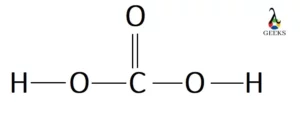Carbonic acid is a mineral acid that contains carbon, oxygen double, and a carbon-hydroxyl group single bond. Let us explain the physical and chemical properties of carbonic acid.
Carbonic acid is a weak and unstable acid that forms carbonate and bicarbonate salts. It rapidly dissociates into CO2 and H2O. In an aqueous solution, it behaves as a dibasic acid which loses two H+ ions. The interconversion between CO2 and carbonic acid occurs in the respiration process in human or animal lungs.
Let us focus on the bonds, melting points, boiling points, reactions, polarity, density, and physical state with many more relevant topics in detail.
Carbonic Acid IUPAC Name
The IUPAC name (International Union of Pure and Applied Chemistry) of carbonic acid is carbonic acid itself.
Carbonic Acid Chemical Formula
Carbonic acid has the chemical formula H2CO3. In this formula, a carbon atom is a central atom and it is attached with two hydroxyl groups (OH) through two single bonds and the rest of the oxygen atom by one double bond.
Carbonic Acid CAS Number
The CAS registry number (authentic numeric identifier which can contain upto10 digits) of carbonic acid is 463-79-6.
Carbonic Acid Chem Spider ID
Carbonic acid has the Chem Spider ID (ChemSpider is a free chemical structure database) 747.
Carbonic Acid Chemical Classification
- Carbonic acid can be chemically classified as a mineral acid or inorganic acid.
- Carbonic acid is also a weak acid because the dissociation constant of H2CO3 is relatively low, and it cannot completely ionize to form carbonate (CO32-) and hydrogen ions. H2CO3 = 2H+ + CO32- (Ka = 4.5 × 10-7).
Carbonic Acid Molar Mass
The mass of 1 -mole carbonic acid is 62.03 g.
Carbonic Acid Color
Carbonic acid shows a green color with an irregular blob when carbon dioxide reacts with water.
Carbonic Acid Viscosity
The viscosity of pure carbonic acid cannot be measured because it cannot be obtained in liquid pure form. It presents as either in an aqueous solution or in a gaseous form.
Carbonic Acid Molar Density
The molar density of carbonic acid is 0.01612 mol/cm3 because it has a density of 1.0 g/cm3.
Carbonic Acid Melting Point
Carbonic acid has a melting point of -800 C or -1120 F.
Carbonic Acid Boiling Point
The boiling point of carbonic acid is 333.60 C or 606.60 F. But when H2CO3 is heated, it gets decomposed into water and carbon dioxide (CO2)
Carbonic Acid state at Room Temperature
Carbonic acid presents as a heavy gas at ambient temperature. The crystalline solid form can only be obtained only at -800 C)
Carbonic Acid Covalent Bond
There are a total of six covalent bonds present in carbonic acid. One double bond is present between sulfur and one oxygen atom and other two single covalent bonds are present between carbon and two OH groups.

Carbonic Acid Ionic/Covalent Radius
The covalent or ionic radius of carbonic acid or any compound cannot be measured as the covalent or ionic radius can only be determined for any single atom, not a compound.
Carbonic Acid Electron Configurations
Electron configuration is defined as the arrangement of electrons in different electronic shells or orbitals. Let us discuss the electron configuration of carbonic acid.
Carbon and oxygen differ in the number of electrons which is [He] 2s2 2p2 and [He] 2s2 2p4 respectively. Hydrogen has an electron configuration of 1s1. Electron configuration is only relevant for any atom that is not attached to any other atoms or groups.
Carbonic Acid Oxidation State
The oxidation state of H2CO3 is zero because it is a neutral compound having no charge. The central atom, carbon is in a +4 oxidation state in carbonic acid. Each of the two oxygen atoms of the OH group is in -1 and the oxygen attached with a double bond is in a -2 oxidation state.
Carbonic Acid Acidity/Alkaline
Carbonic acid is a weak inorganic acid with pka values of 6.77 (pka1) and 9.93 (pka2).
Is carbonic acid odorless?
Carbonic acid is an odorless gaseous compound, but it has an alkaline taste.
Carbonic Acid Hydrates
- Carbonic acid is nothing but hydrated carbon dioxide molecules. The crystal of this weak acid contains water molecules (known as crystal water) and forms hydrates, H2CO3.nH2O in which n can be 1,2,3, and 4.
- The oxygen atoms of carbonic acid can also act as hydrogen bond acceptor and the hydrogen atoms as hydrogen bond donor. Thus, carbonic acid form hydrates in aqueous solution.
Carbonic Acid Crystal Structure
Solid carbonic acid possesses a monoclinic crystal structure. The space group of the sulfuric acid crystal is p21/c having formula units of 4 in a cell with the dimensions a= 5.392 A0, b= 6.661 A0, c= 5.690 A0, and α= 900 β= 92.660 γ= 92.660.
Carbonic Acid Polarity and Conductivity
- Carbonic acid is a polar compound because of its polar bonds and relative arrangement of the polar bonds. Therefore, it has a permanent dipole moment of 0.10491 Debye.
- As Carbonic acid is dissociated into carbonate and hydrogen ions, it conducts electricity in an aqueous solution. H2CO3 = 2H+ + CO32-
Carbonic Acid Reaction with Acid
Carbonic acid does not react with any acid because it shows acidic nature.
Carbonic Acid Reaction with Base
Carbonic acid reacts with base (having OH group) and forms salt and water.
- 2NaOH + H2CO3 = Na2CO3 + H2O
- 2KOH + H2CO3 = K2CO3 + H2O
Carbonic Acid Reaction with Oxide
Carbonic acid reacts with metal oxide (ZnO) and forms metal carbonate (ZnCO3).
- H2CO3 + ZnO = ZnCO3 + H2O
Carbonic Acid Reaction with Metal
- Carbonic acid does not react with metals in their pure form to form metal carbonates.
- They are formed by the reaction of a strong base like NaOH, KOH, or metal oxide and carbonic acid.
Conclusion
Carbonic acid has a wide range of applications in different fields. It is used in the beverage industry to prepare drinks, and in the laboratory to precipitate ammonium salts. One of the most important biological roles of carbonic acid is to be an intermediate in the respiration process.

Hello,
I am Aditi Ray, a chemistry SME on this platform. I have completed graduation in Chemistry from the University of Calcutta and post graduation from Techno India University with a specialization in Inorganic Chemistry. I am very happy to be a part of the Lambdageeks family and I would like to explain the subject in a simplistic way.
Let’s connect through LinkedIn-https://www.linkedin.com/in/aditi-ray-a7a946202